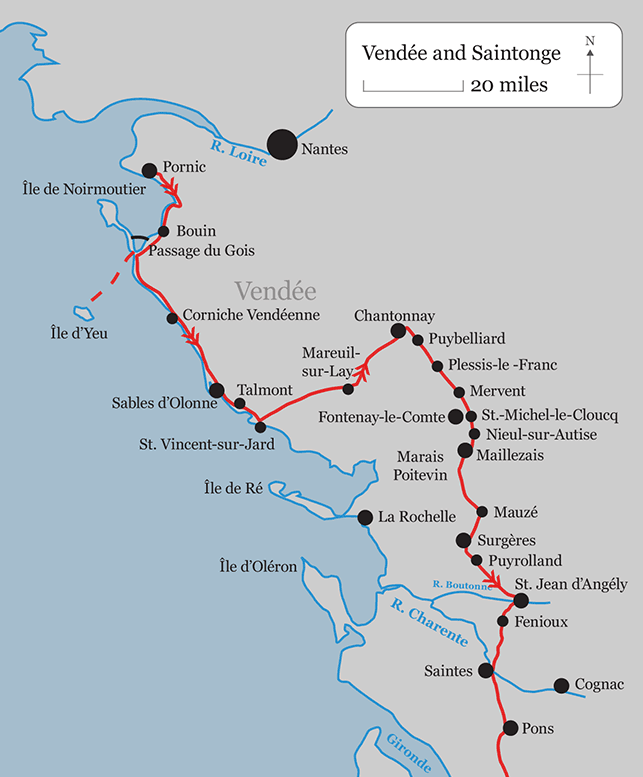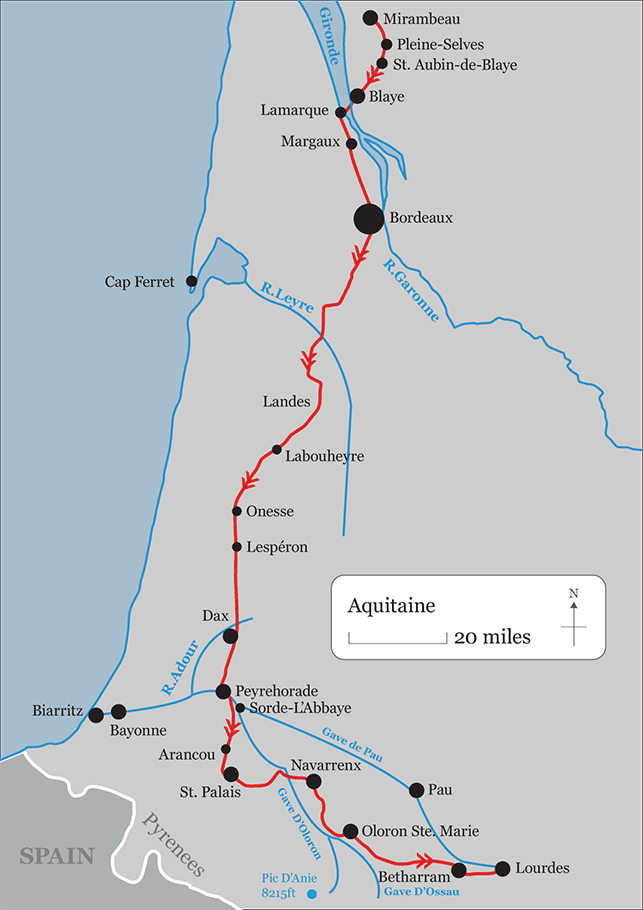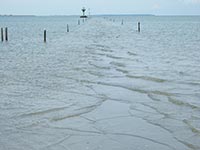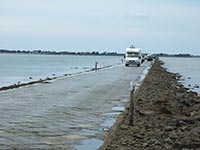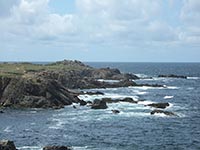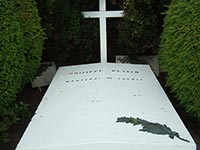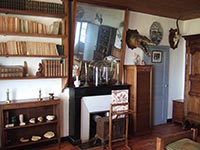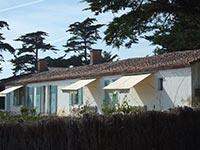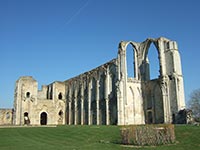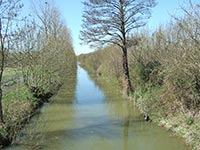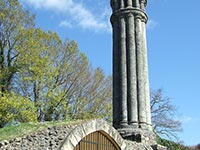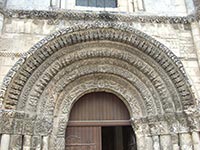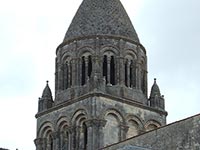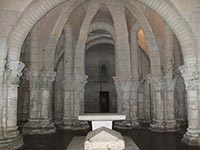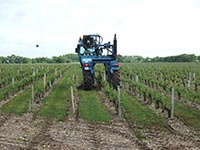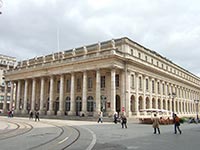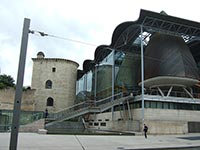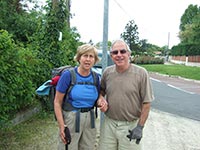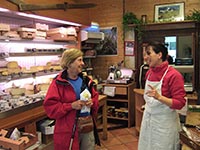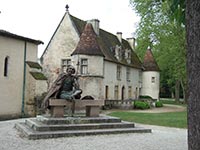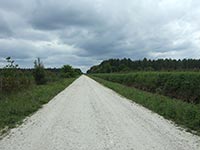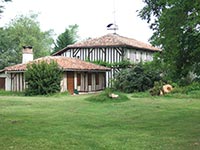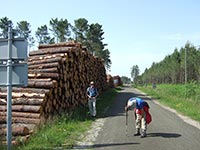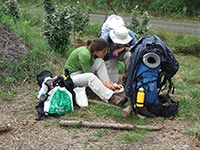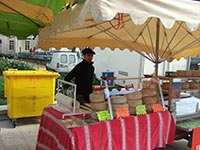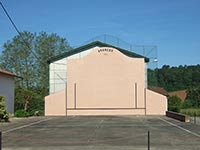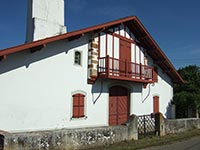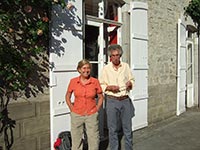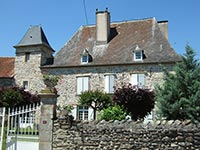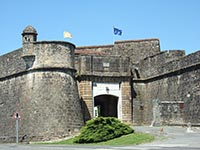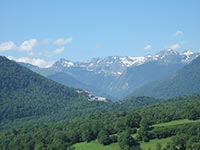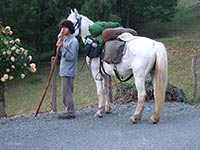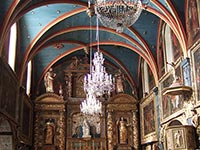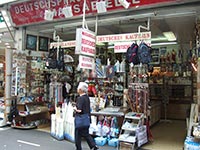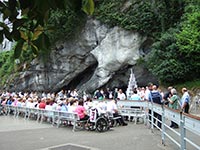South West France
Photo: Terry offered a bottle of wine near Margaux
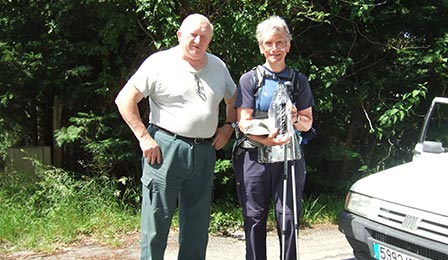
The region
Vendee
Much of the coast is lined with camp sites, mobile homes, apartment blocks and estates of neat villas.
Georges Clemenceau, Prime Minister at the end of World War One, had a simple retirement cottage on the dunes where, after fifty years in politics, he wrote about Asian religions and enjoyed a garden designed with Monet's help. Now it is surrounded by the tide of development.
There are four different types of landscape - the coast, the marshes, the bocage and the plains.
Most of the coast consists of sand dunes, which are very fragile unless bound together by vegetation. In one great forest planted to preserve the coastal defences there are small Mediterranean oaks which thrive in the mild climate on the Atlantic coast.
The north and south coasts of the Ile d'Yeu present an extraordinary contrast. The north shore consists mainly of dunes. The south coast looks like part of Brittany, which geologically it is, consisting of granite with small amounts of quartz.
Behind the dunes of the Vendee are two great areas of reclaimed marsh land, one in the north from the Pays de Retz to Sables d'Olonne, and the other in the south, the Marais Poitevin. Much of the Ile de Noirmoutier is reclaimed land below the highest tides. The abbots of the great monasteries like Nieul-sur-Autise and Maillezais first drained the southern marsh in the twelth century.
The Vendee produces a diverse range of agricultural products - not only meat and dairy in the bocage and cereals on the plain. One woman outside a farm told me about the 6.000 ducks in a shed which would probably end up as confit de canard. Small vineyards can be found dotted around the Vendee but most of them only produce wine for local consumption. I saw orchards of apples, rows of artichokes more typical of Brittany and one smallholder near the marshes producing tobacco.
The Vendee does not have any large towns. However its transformation from rural backwater to modern diversified economy, embedded in small towns in the countryside, is one of the success stories of post-war France.
The bocage and the marshes provided ideal cover for the Royalist Chouan rebels who fought a bitter war against Republican troops after 1793.
The Vendee is part of what the French call Le Grand Ouest, an arc of departments on the western seaboard, whose populations have grown substantially in recent years at the expense of the older industrial areas to the north and east. Retired people have moved in, as well as young families seeking work in the new industries and a more pleasant environment to bring up their children.
South of the Loire curved red tiles replace slate roofs. Most Vendee farmhouses are single storey as if huddled up against the Atlantic gales. Walls are white washed to reflect the sun and shutters often painted in bright colours.
Saintonge
The countryside alternates between rolling plain and patches of bocage.
The predominant crop is grapes, interspersed with perfectly drilled rows of wheat , tobacco, apples and the occasional patch of woodland.
The Saintonge was a separate province of the old French kingdom which became the more prosaic Charente-Inferieure and then Maritime after the Revolution. It has its own recognised regional language, a branch of the southern Occitan tongue, and a distinct character, three aspects of which I particularly noticed - the cultural heritage of Rome and the local Romanesque style of the High Middle Ages, the vineyards producing for Cognac and its position across the major route from Paris to Bordeaux.
Saintes was a Roman town complete with an arch, an arena and an aqueduct.
Medieval builders in the Saintonge replicated those simple Roman arches many times on the west fronts of churches and abbeys but transformed them into wonderful galleries of sculpture. Minstrels, grotesque faces and fabulous beasts come alive alongside angels and apostles. The signs of the Zodiac are a common theme as well as friezes of intricate foliage. On the church front at Fenioux devils with tails are pushing wrongdoers into the flames of hell. At Sainte Marie in Saintes we can see the gruesome sufferings of the early Christian martyrs. Belfries with arcades of classical columns rise above these sanctuaries, often surmounted by a roof of interlocking stone tiles like a pine cone.
One of the main pilgrimage routes to Compostela passes through this area and there are many historic monuments decorated with the cockle shell.
Gironde
The Gironde estuary at over 100 kilometres long is the largest in Europe.
After the extensive vineyards of the Cotes de Blaye on the right bank, I passed through the famous Medoc, were vines grow in beds of gravel scattered with large stones.
Bordeaux
Eighteenth century Bordeaux flaunted its commercial success - the self-confident facade of the Palais de la Bourse, with its opulent stone work and imposing windows looking down on the Garonne; the high arched doors of the merchants' houses on the Quai des Chartrons watched over by contorted faces sculpted in stone - the mascarons.
Now the majestic sweep of the river, the moon as the Bordelais call it, is practically deserted.
Then as now the French state took a guiding role in creating a magnificent city, which would attract people from far and wide. The Intendant Tourny, for which today read prefect or even mayor, laid out the stately allee which bears his name.
The more intimate medieval city lies alongside with its narrow winding streets, small squares and turreted gates.
Since 1945 the state has intervened to rejuvenate Bordeaux once again. In the last thirty years two powerful mayors and regional authorities with clout have used public money to create an urban environment in which humans can wander around and feel at home. The esplanade along la lune, with its gardens and miroir d'eau, and the new law courts, designed by Richard Rogers, are admirable examples of how a city can be transformed.
So, as in the eighteenth century, a prosperous and diversified economy has encouraged outsiders to work and retire here or to come and play in the many seaside resorts only an hour away.
Landes
Today's forest is an entirely artificial landscape. Until the middle of the nineteenth century the Landes was a two million acre heath with few trees and extensive marshes. It was Napoleon III who started the programme to drain the Landes and plant pine trees, which provided a more solid basis for the economy of the region.
Between the plantations smaller woods of deciduous trees, such as oak, and tangled masses of vegetation grow in waterlogged black peat. There are still stretches of the original heathland with wide horizons, green apart from the bright yellow of gorse and cistus.
Plenty of conventional crops grow in the Landes - maize, asparagus, peas, lettuces and carrots. Ducks and chickens are also raised in large numbers. Much of the soil is sandy. Large pumps draw water from less than a metre below the surface of this former bog.
The traditional single storey dwellings have roofs supported by vertical wooden beams separated by brick or plaster. Many of these cottages belonging to humble forest dwellers have been restored and are now highly desirable second homes.
In January 2009 a cyclone ripped through the Landes destroying 60% of the trees. Parts of the forest look like a First World War battlefield. Now there is a vast surplus of unsaleable wood and EU aid has been offered to assist replanting.
The Bearn
The rivers draining the Pyrenees are called gaves and most of them run into the Gave de Pau, before it in turn joins the Adour. They are full of opaque ice green water flowing very fast and totally unsuitable for navigation.
The flat fertile land of the river valleys is entirely different from the surrouonding hill country. Near Sorde l'Abbaye most of the fields seemed to be full of Kiwi fruit. Large pebbles lay scattered on the ground, no doubt washed down by the gave. Some of them had been used to build farmhouses.
Later the path crossed the wooded foothills of the Pyrenees with grandstand views of the great peaks.
In the Middle Ages a few major abbeys like Sorde controlled the life of the whole region. The abbey ruins and the large church still contain evidence of their creativity and ingenuity - the intricate patterns of the mosaic floor behind the high altar, the galleries in the cliff by the Gave d'Oloron to land and store merchandise; the well full of clear water filtered by sand; the network of channels and basins for gutting salmon.
Some Bearnais farmhouses are tall and rectangular, their slate roofs soaring towards the sky at a dizzying angle. Solid mullioned windows, towers and stone arched doorways suggest a prosperous agriculture in centuries gone by.
The Basques
There are seven Basque provinces, four in Spain and three in France. I entered the middle of the three French ones known as Basse Navarre. Beyond St. Palais my path lay through the eastern one called Soule. The third runs along the coast.
Navarre used to be a mighty kingdom stretching both sides of the Pyrenees and incorporating the Basque lands. In 1521 the Spanish King conquered the provinces of Navarre south of the Pyrenees and the royal house of Navarre fled north to St. Palais and Navarrenx, which was turned into a royal fortress. Navarre was eventually incorporated into the royal province of the Bearn. Whereas in Spain the Basques enjoy autonomous regional government, in France they have no special status.
There are around 800,000 Basques living in France. While the language is taught in some schools and road signs are repeated in Basque, less than 60% speak it regularly and the language has no official status. Most Basques in France just want to preserve their culture. They are not interested in political agitation.
The farmhouse, where an extended family group lived with their animals, was the basis of society. Typically the traditional Basque house looks a bit like a Swiss chalet. It has a large sloping roof, with living rooms on the first floor opening onto a balcony. Often the latter is quite elaborate, with carved or fretted woodwork, and it overhangs the street. Underneath a large doorway gives access to the space for animals, hay and farm implements. Usually the exterior woodwork is painted in a special red which is said to be like the blood of bulls.
The Basques were also sailors and merchants but many settled permanently overseas, mainly in South America. The eldest son always inherited the family farm. Often the younger sons had no prospects so they left their homeland. As a result a significant proportion of the populations of Argentina, Chile and Uruguay are of Basque origin.
The Basques also seem to be attached to symbols of their culture. Everywhere I saw the Basque cross, which looks like four joined up apostrophes, and in churchyards the gravestones are often discoid in shape . The Basques also enjoy traditional games of which the best known is pelote, an outdoor version of real tennis played against a wall, with a basket for a racquet attached to the arm. Every village has its court from which the Basque flag flutters, a white cross on the Basque red background with a green diagonal cross as well. The last symbol which many men wear is the black beret.
Lourdes
Bernadette Soubirous first saw the Virgin in 1858 and since then Lourdes has become a major pilgrimage centre for Roman Catholics. 5 million people come every year, which in terms of bed nights ranks Lourdes second only to Paris. Many of them have incurable diseases and come to pray for a miracle. The outpouring of faith is impressive even if Lourdes seems to represent religious observance on an industrial scale.
Back to top
Diary extracts
Outstanding hospitality
On my first night on the Chemin de St. Jacques I was offered free hospitality by Blanche, a widow who lived next door to her son and his family on the farm. She told me about the choral group to which she belonged. Taking out a book of Christmas carols familiar to English ears, she asked if I could sing them for her. So there I was tackling "Angels in the realms of glory" in the middle of France and completely out of season. She then said "I have to look after some grandchildren twenty miles away for two days, so you can have the run of my house. Patricia, the daughter-in-law next door will feed you!" How trusting of a complete stranger! "She is always doing this," said Patricia, "and she has nothing worth stealing."
Characters on the pilgrimage routes
Bruno walked with me until we reached a village called St. Palais, where I wanted to look at some irreverent gargoyles on a Romanesque church. Bruno was not the slightest bit interested. He explained that he did not bother with photos and never stopped. He had to cover 35 kilometres a day. Bruno was slim and moved fast. "I am a runner," he said. "I have never done a major walk before." When we started off in the morning I was amazed to see that he did not heave his rucksack onto his back but proposed to drag it along behind him."I have hurt my shoulder," he said, "so I have designed this trolley with three wheels each side, specially made to roll over rocks!" He proceeded to attach his trolley to a belt around his waist. The whole contraption looked very uncomfortable. "How do you manage on a grassy track," I asked. "It is a bit of a problem if the grass is too long. It gets stuck in the wheels! So I walk mainly on the roads."
Outside a row of bungalows a small car halted behind me and suddenly I felt a firm hand on my shoulder. An enormous hulk of a man held me in his grasp, while his wife thrust a dubious bottle of wine without a label into my hand. "You must take this," he said. "It will make you strong for the pilgrimage." I feared drinking a whole bottle of rose for lunch would ensure I never reached Bordeaux. Then he rummaged in his pocket, pulled out eight euros and thrust them into my palm. "You will need this too to help you on your journey." I protested in vain in my English way "Look, it is very kind of you but I am sure there are others more deserving...." He would not take no for an answer, so I put the coins in my pocket and thanked him profusely. He introduced himself. "I came from Poland many years ago and settled here, working as a mechanic. My wife is from Belgium. Now I am retired but I have had a good life here. Would you like to come to lunch?" He beckoned towards the garden of one of the bungalows. With some regrets I declined "I must reach Bordeaux tonight." "Then I will drive you there after we have eaten. " "Yes but I prefer to walk. That's what I am here to do." Somehow I extracted myself from his warm embrace and plodded on clutching my bottle of wine and eight euros.
I plodded out through the southern suburbs of Bordeaux and was not entirely surprised that more local people wanted to stop and say hello. One man jumped out of his car with a broad grin on his face to tell me where I was going wrong. I had a job to convince him that a slight adjustment to the route was permissible in my case, "I have been to Compostela four times," he said,"as well as trekking to the shrine of Our Lady of Fatima which is much more moving." He was not very impressed when I said I would prefer not to cover forty kilometres in one day's walk in the Landes. "I have had a stent fitted in my heart and I have done it!" he exclaimed. A worker on a building site shouted out "your're not in Compostela yet!" Just as I left Gradignan I bumped into Michel, the President of the local association of Jacquaires. "I have done the pilgrimage ten times and met my wife on the trail into the bargain." While walking alongside an autoroute for several miles, motor bikers peeped, motorists waved and lorry drivers honked their horns.
Eric came from Domfront in the Orne and religious practice clearly meant something to him. Strong and fit he had decided to take two months off between jobs and walk all the way to Compostela from his native Normandy. "I do not think we should ask each other what we do at home," he said. "We should accept people as they are and not prejudge them on the basis of occupation, race or class. I want to avoid the stress of the work place. I love meeting people in an unstructured way. You learn to weigh the effect of your words on others and not to be judgemental. Every day is an adventure. Now I have a chance to reflect and change my life." At the priory at Gradignan he had picked up a tall powerfully built Spanish girl called Esther, who had tattoos on her legs and feet. Taking time out and doing the St. Jacques fitted into a period backpacking around Europe. She spoke a few words of French mixing it liberally with her native tongue and prefacing every remark with "OK!" and an extravagant gesture with her arms. "When I reach Cap Finistere," she said, "I will throw my rucksack away and all the rubbish in my life and start again." Esther was a vegetarian and did not eat dairy products because she said they caused excess levels of mucus. Eating meat resulted in impurities in the blood. She wanted to rid her body of all these toxic substances. She had a small rucksack but it weighed a ton because she was carrying all sorts of healthy food - a litre of olive oil, lettuce, tomatoes, avocado, mushrooms, chick peas, quinoa and bread. Eric may have been dying for a steak but Esther had trained him to eat salad sandwiches, although we noticed at lunch that he managed to sneak some dried sausage into the meal.
I rested in the shade of an oak tree with a view of peaks wrapped in a translucent veil of haze. Suddenly a pilgrim called out to me from a few yards away asking for help. "I am lost. Where am I? Italia! Italia!" I found it difficult to understand his confusion because I was only a short distance from a village on the St. Jacques trail. Surely he did not think he was in Italy. He looked distracted and there was a strange glow in his eyes, as if he was not of this world. He carried a long wooden staff with an amethyst and a crystal ball on top. A large gold cross hung around his neck. "I am walking to Fatima in Portugal," he said, "and then back to Compostela." That evening Annie at my B & B said "you meet a lot of people like him on the chemin.Un peu illumine." She meant with more than a touch of irony that a heavenly light surrounded them.
Back to top
The Walk
View more details.
View more details.
From Pornic I followed the coast path GR8 all the way to Sables d'Olonne (with local variations, particularly south of Bretignolles-sur-Mer, and also visiting the Ile de Noirmoutier via the passage du Gois and the Ile d'Yeu). After les Sables I continued on local paths, not far from the coast, to Saint Vincent-sur-Jard. Then I turned inland on local footpaths through Avrille, Mareuil-sur-Lay and Bournezeau to Chantonnay. Just beyond there I joined the Santiago pilgrimage trail coming from Mont St. Michel and Nantes, which took me to Saint Jean d'Angely in the Charente. From here I continued on the Chemin de Tours, the Santiago trail coming from Paris, walking along it through Saintes, Pons, Mirambeau, Blaye and Lamarque to Bordeaux. After that I persevered on the same trail across the Landes to Dax, Sorde l'Abbaye and Saint Palais. From here I proceeded east back up the Chemin du Puy in the wrong direction until I reached Navarrenx. Then I cut across country to join the Chemin du Piemont Pyreneen, again walking in the wrong direction, until I reached Lourdes. The total distance was appoximately 560 miles.
Back to top
Maps and Guides
Pornic to Chantonnay: IGN 1:25.000 maps 1123OT, 1125OT, 1126OT, 1227OT, 1328OT, 1227E, 1327O, 1327E, 1326E, 1426O.
Chantonnay to Saint Palais: Le Chemin du Mont-Saint-Michel vers Saint-Jacques-de-Compostelle. A pied du Mont a Saint-Jean-d'Angely. Rando Editions. Le Chemin de Paris et de Tours vers Saint-Jacques-de-Compostelle. De la Seine et de la Loire aux Pyrenees. Rando Editions.
Saint Palais to Lourdes: Topoguide. Sentier vers Saint-Jacques-de-Compostelle Le Chemin du PuyRef. 653. FFRP. IGN 1;25.000 maps 1445E, 1545O. Le Chemin du Piemont Pyreneen vers Saint-Jacques-de-Compostelle. De la Mediterranee a Roncesvaux. Rando Editions.
Back to top
Weather
This was flat easy walking with no particular weather problems. It was hot even in May and there are few settlements in the Landes so take plenty of water.
Back to top
Accommodation
I list below places where I stayed that I can particularly recommend. I have not covered every stopping place on my route. Some of the hostels on the Compostela trails can be full during holiday weekends and the peak season, so pre-booking is advised.
Hotel les Douves
11 rue des Douves
85330 Noirmoutier en l'Ile.
Tel. 00 33 (0)2 51 39 02 72
fax 00 33 (0)2 51 39 73 09
Chambres d'hotes Le Cabanon du Pecheur
Claude et Lysiane Groisard
49 rue Saint Hilaire
85350 l'Ile d'Yeu
Tel. 00 33 (0)2 51 58 42 30 or
06 23 06 62 07
Chambres d'hotes La Piniere
Bertran Carayol
85440 Talmont St. Hilaire
Tel. 00 33 (0)2 51 22 25 66 or
06 70 30 55 16
http://www.gites-de-france.com/gites/fr/chambres_d_hotes
Chambres d'hotes Elisabeth Grolleau
21 rue de l'Ocean
85320 Les Pineaux
Tel. 00 33 (0)2 51 30 55 04 or
06 09 49 52 26 0r 06 20 21 05 95
http://www.gites-de-france.com/gites/fr/chambres_d_hotes
Gite du Village de la Barre
Mme. Blanche Olivier
Tel. 00 33 (0)2 51 51 50 80
Le Pot Bleu
Sylvie Gouineau
85200 Pissotte
Tel. 00 33 (0)2 51 51 48 77 or
06 88 73 83 42
Le Relais des Pictons-Chambres d'hotes
Genevieve Mougard
27 rue du champ de foire
85420 Maillezais
Tel. 00 33 (0)2 51 87 21 95
http://www.gites-de-france.com/gites/fr/chambres_d_hotes
La Venise Verte-Chambres d'hotes
Monique Proust
12 place de l'Eglise
79210 Saint Hilaire la Palud
Tel. 00 33 (0)5 49 35 52 40 or
06 50 34 91 00
Chambres d'hotes M et Mme. Delage
41 avenue du General de Gaulle
17700 Surgeres
Tel. 00 33 (0)5 46 07 28 52 or
06 26 40 12 93
Chambres d'hotes Danielle et Jean-Pierre Galand
2 chemin du Vallon
17100 Venerand
Tel. 00 33 (0)5 46 97 79 65 or
06 98 06 27 19 or 00 33 (0)5 46 97 74 53
Hotel Les Messageries
rue des Messageries
17100 Saintes
Tel. 00 33 (0)5 46 93 64 99
Fax 00 33 (0)5 46 92 14 34
info@hotel-des-messageries.com
http://www.hotel-des-messageries.com
Chambres d'hotes Ingrid Chrismann
33 rue Charles de Gaulle
17800 Pons
Tel. 00 33 (0)5 46 93 66 50 or
06 89 51 44 25
http://www.gites-de-france.com/gites/fr/chambres_d_hotes
Chambres d'hotes-Chateau Le Grand Moulin
Yolande Reaud
La Champagne
33820 St Aubin de Blaye
Tel. 00 33 (0)5 57 32 63 58 or
05 57 32 62 06
Fax 00 33 (0)5 57 32 73 73
http://www.chateaucountry.com/fr/chateau_le_grand_moulin-207
Le Chalet Lyrique
169 Cours General Charles-de-Gaulle
33170 Gradignan
Tel. 00 33 (0)5 56 89 11 59
Fax 00 33 (0)5 56 89 53 37
Hotel Le Resinier
N.10
33114 Le Barp
Tel. 00 33 (0)5 56 88 60 07
Fax 00 33 (0)5 56 88 67 37
Hotel-Restaurant Le Cafe de Pissos
42 rue du Pont Battant
40410 Pissos
Tel. 00 33 (0)5 58 08 90 16
Fax 00 33 (0)5 58 08 96 89
Auberge Caule gite d'etape
35 route de Mimizan
40110 Onesse et Laharie
Tel. oo 33 (0)5 58 07 30 01
Hotel Le Central
place Aristide Briand
40300 Peyrehorade
Tel. 00 33 (0)5 58 73 01 44
Fax 00 33 (0)5 58 73 01 56
http://www.hotel-le-central.fr
Gite Bourthaire (Association Jacquaire),
(President Jean-Pierre Loubet)
c/o Mairie d'Arancou
64270 Arancou
Tel. 00 33 (0)5 59 38 42 65 (Secretariat Mairie d'Arancou)
Muriel (responsable accueil) Tel. 00 33 (0)5 59 38 49 04
President de l'Association Jacquaire d'Arancou Tel. 00 33 (0)5 59 31 63 14
http://www.gitepaysbasque.fr/association-jacquaire-arancou
Chambres d'hotes Maison d'Arthezenea
Francois Barthaburu
42 rue du Palais de Justice
64120 Saint Palais
Tel. 00 33 (0)5 59 65 85 96 or
06 15 85 68 64
francois.barthaburu@wanadoo.fr
http://www.gites-de-france.com/gites/fr/chambres_d_hotes
Relais du Jacquet
42 rue Saint Germain
64190 Navarrenx
Tel. 00 33 (0)5 59 66 57 25 or
06 75 72 89 33
contact@chambre-hotes-navarrenx.com
http://www.chambre-hotes-navarrenx.com
Chambres d'hotes L'Amphitryon
Patrick et Corinne Diaz
23 place Saint-Pierre
64400 Oloron-Sainte-Marie
Tel. 00 33 (0)5 59 39 78 50 or
06 81 57 43 58
http://www.amphitryon-oloron.com
Hotel de France
1 place de l'Hotel de Ville
64260 Arudy
Tel. 00 33 (0)5 59 05 60 16
Fax 00 33 (0)5 59 05 70 06
http://hotel-france-arudy.vallee-ossau.com
Annie et Joseph Latapie - Chambres d'hotes
La Croix des Hauteurs
64800 Lestelle Betharram
Tel. 00 33 (0)5 59 71 96 18
http://www.gites-de-france.com/gites/fr/chambres_d_hotes
Back to top
Photographs
Click on the thumbnails below to see larger images with captions.

